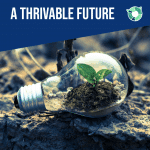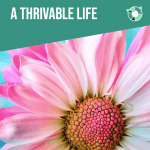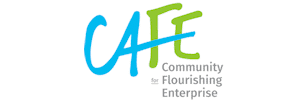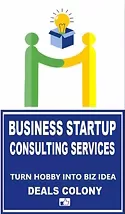The THRIVE project expresses its heartfelt appreciation to Cameron Price, Simone Grasso & Valerie Itey for their insightful presentations at the April 2024 Thrivability Matters Webinar. We thought you were awesome and well worth listening to. Each subject was interesting and illuminating. The focus of this webinar centred around the United Nations Sustainable Development Goals (SDGs). The theme of April 2024 is SDG13: Climate Action, covering additional topics such as Mitigation and Adaption, Value-Based Innovation. Here are our webinar highlights!
About The April 2024 Speakers

Cameron Price is a graduate of forest science and a candidate for a master of sustainability. He is deeply involved in sustainability education and consultancy worldwide. With roles ranging from training at the Australian College of Business Intelligence to advising at green-tech start-ups Yenna Tech and Climateers, and providing sustainability consulting for Synertium and Strategy&Ops, his work focuses on implementing nature-based solutions and advancing ecosystem restoration. He is passionate about making a tangible impact on biodiversity conservation and sustainable operations.
Simone Grasso, a sustainability-driven business developer and circular economy lecturer. He holds a dual degree in Economics, Management, and Policies for Global Challenges, specialising in Green Economy & Sustainability, with honours from the University of Ferrara and Southern Denmark University. Throughout his career, he has actively promoted circular economy principles by leading the development of the green-tech startup Cyrkl in Italy for 2.5 years. He now focuses on educating young students and professionals to drive progress and innovation in sustainability.


With over 25 years of experience in technology and international business development, Valerie Itey specialises in using design thinking and impact technology to harness innovations and create a sustainable future for all. Her passion lies in developing strategies that combine business-driven results with the circular economy and impactful sustainable initiatives supported by the latest science and technology. She believes that innovation thrives on collaboration. Her wealth of international experience in IT products, marketing and business innovations lead her to pivotal roles in ventures such as telco company Orange, Gemalto’s acquisition of Netsize, and Index’s acquisition of Haiku.
Summary Of The April 2024 Webinar
As an organisation, the THRIVE Project endeavours to guide humanity towards a more sustainable future. We had the privilege of hosting these two speakers as guest presenters for our webinar.
Cameron Price – Using Living Systems as Climate Solutions
Cameron Price began by defining nature-based solutions (NbS) and illustrating their potential to address societal challenges. NbS involves using living systems to resolve problems such as climate change, biodiversity loss, and water insecurity. Since being formally defined in 2016, NbS has gained momentum. This is driven by funding mechanisms like carbon credits and large-scale forest planting projects. These solutions aim to protect, manage, and restore ecosystems, providing simultaneous benefits for human well-being and biodiversity.
Cameron emphasised the role of NbS in tackling the climate crisis by sequestering carbon through vegetation. Planting trees and restoring ecosystems draw carbon from the atmosphere, helping offset emissions from human activities like fossil fuel combustion. NbS also addresses food and water security, providing livelihoods and economic benefits to communities engaged in these projects. The goal is to achieve societal development while enhancing biodiversity and safeguarding human well-being.
The International Union for Conservation of Nature (IUCN) has established a global standard for NbS, providing a framework for project design and implementation. Key criteria for NbS include environmental sustainability, social equity, economic viability, and adaptive management. Practical examples include using wetlands for stormwater management, which can reduce the need for extensive and ugly concrete infrastructure, and planting mangroves to protect coastal areas from storm surges. These projects can also provide recreational and aesthetic benefits, improving the quality of life in urban areas.
Cameron showcased the transformative impact of urban green spaces. Parks, green roofs, and green walls not only beautify cities but also improve air quality, mitigate the urban heat island effect, and provide mental health benefits. These spaces help prevent heat stroke, the leading cause of climate change-related deaths, by cooling urban environments. By integrating green infrastructure, cities can create healthier and more resilient communities.
Cameron’s presentation underscored the holistic nature of NbS in addressing complex social and environmental challenges. By leveraging natural systems, NbS can mitigate climate impacts, support biodiversity, and enhance human well-being. Integrating NbS into our landscapes is an essential step forward for sustainable development, blending the ingenuity of nature with human innovation.
Simone Grasso – Towards Circular Economy: Challenges and Opportunities in Europe
Simone Grasso’s presentation provides an insightful overview of the current state and future prospects of the circular economy in Europe. He highlights that the circular economy is slowly approaching mega trend status, with Europe leading the charge through innovative policies and practices. Despite Europe’s progress, the economy remains predominantly linear, with a significant reliance on virgin materials. These ongoing challenges illustrates the need for a broader adoption of circular economy principles to address resource depletion and environmental impact.
Simone addresses a common misconception that circular economy primarily revolves around waste management. It encompasses much more, including eco-design, resource longevity, and the integration of renewable energy. The presentation underscores the importance of extending the life cycle of products through reuse, repair, and high-quality recycling, rather than merely focusing on disposal. By emphasising these broader aspects, Simone aims to correct the narrow view of circular economy as solely waste-centric.
Recent reports reveal that while Europe has a relatively high circularity rate than the global average, progress has been slow. The circularity rate in Europe, though positive, has remained relatively flat over the past decade. Despite the promising figures, significant improvements are needed to align with climate targets and achieve sustainable development goals. A profound transformation of economic practices is still needed to effectively leverage circular economy benefits.
Simone concluded with a forward-looking perspective on the potential of circular economy principles. He introduced innovative business models that can offer both environmental and financial benefits by keeping ownership and responsibility within the producing company. His presentation stressed that adopting circular economy practices can reduce environmental impact while fostering economic growth. By showcasing successful examples and highlighting the role of digitalisation and policy support, Simone advocates for a global effort to integrate circular economy principles into everyday business and economic strategies.
Valerie Itey – Values-Based Innovation for climate change and caring for Water
In her insightful presentation, Valerie Itey delves into the transformative potential of value-based innovation within the framework of a circular economy. Valerie emphasises the urgent need to rethink our consumption patterns and product lifecycle to combat climate change effectively. Highlighting the finite nature of our planet’s resources, she advocates for a shift towards sustainable practices that harmonise business success with environmental stewardship.
Valerie introduces the concept of the circular economy as a paradigm shift from traditional linear models of consumption. True innovation isn’t simply creating new products but designing them with their entire lifecycle in mind. This approach necessitates careful consideration of product end-of-life, encouraging designs that facilitate reuse, repair, or recycling. By integrating life cycle assessment (LCA) into product development, businesses can quantify and compare the environmental impacts of different materials and processes, leading to more sustainable choices.
A key theme of the presentation is the role of community and collaboration in driving sustainable change. There is a vital importance to engage local communities and to leverage collective knowledge to address environmental challenges. Valerie points to various initiatives, such as clean-up campaigns and educational programs, that foster greater awareness and action. She also highlights how digital tools, such as sensors and IoT technology, can enhance our understanding and management of environmental issues such as water pollution. These innovative solutions offer new insights into environmental impact through advanced monitoring and analytics, paving the way for more effective and informed responses.
Valerie concluded by highlighting the hidden power of art and creativity in environmental advocacy. Artistic projects can raise awareness and inspire action by visually communicating the impact of pollution better than speeches, facts and figures. By merging creativity with technology and community engagement within a circular economy framework, Valerie envisions a future where innovative solutions and collaborative efforts lead to a more sustainable and resilient world.
Moving Forward From April 2024
The Thrivability Matters Webinar for April 2024 showcased insights from Cameron Price, Simone Grasso & Valerie Itey. If you missed the presentations or the live Q&A session, you could view the recordings on our YouTube channel or download the PDFs from each of the speakers.
If you’re interested in joining us after the April 2024 Thrivability Matters Webinar, there are a variety of avenues you can take. One way of keeping up with us is via social media platforms, such as LinkedIn, X, Instagram, and Facebook. However, you could subscribe to our YouTube channel, listen to our podcasts, sign up for our newsletter, stay up to date with our blogs, attend our free webinars, or even join us as a volunteer to make an even bigger difference in this world.
Interested in Gender Equality and Reduced Inequalities?
Want to be kept in the regenerative loop with THRIVE?
Got more questions?
Ask an expert!























